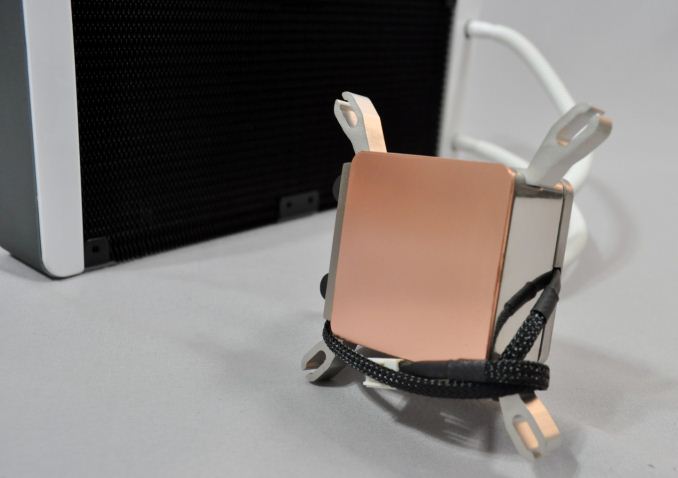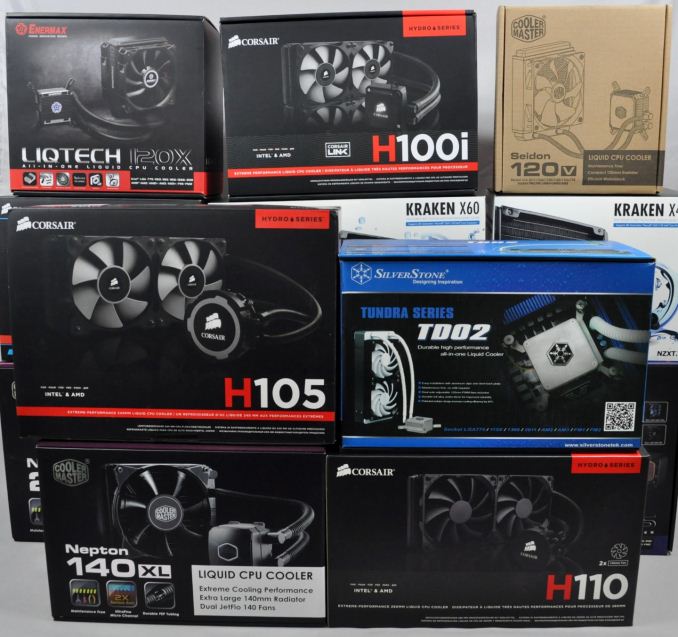Closed Loop AIO Liquid Coolers: 14-way Mega Roundup Review
by E. Fylladitakis on February 12, 2014 7:00 AM EST
Remember the time when liquid cooling a computer chip was considered to be an extreme approach, one performed by hardcore enthusiasts and overclockers alone? Everything had to be personally designed and or procured by the user, as there were no specialized commercial products available at the time. Radiators were modified heater cores extracted from cars, CPU blocks were rare and occasionally machined at local workshops using a copper block and a lathe, while high-performance tubing came from shops with medical supplies.
As demand grew, aided by the ever-increasing noise of small CPU heatsinks, companies specializing on liquid cooling solutions began turning up -- a little too fast perhaps, as tens of companies were founded within a few months' time and very few of them actually survived for more than a couple of years. Enthusiasts could then buy specialized liquid cooling equipment and even whole kits from just one seller and only had to assemble the setup into their system. That of course is no simple process for an amateur and a nightmare for a system builder, who cannot ship a system with a topped off water cooling tank or assume that the user has the skills required to maintain such a system, therefore the potential market remained limited to advanced users only.
This all changed in 2012, when Asetek came up with an inexpensive closed loop solution, a liquid cooling device that was leak-free and required no maintenance at all. The radiators of the first few solutions were small and their overall performance hardly better than that of air coolers; however, aided by the modernization of computer cases, the mounting of larger, thicker radiators inside a PC soon was not a problem. In many cases the kits were now no harder to install than any CPU cooler and required no maintenance at all, opening the market to virtually every computer user seeking a performance cooling solution. This spurred massive interest amongst OEMs and manufacturers, who all strive for a slice of the pie.
There have been tens of AIO (All-in-One) closed loop liquid coolers released just in 2013; today, we are having a roundup with 14 of them, coming from five different manufacturers, alphabetically listed in the table below.
| Product | Radiator Effective Surface | Radiator Thickness | # of Fans (Supplied / Maximum) | Speed Range of Supplied Fans (RPM) | Current Retail Pricing |
| Cooler Master Seidon 120V | 120mm × 120mm | 27mm | 1 / 2 | 600-2400 | $49.99 |
| Cooler Master Nepton 140XL | 140mm × 140mm | 38mm | 2 / 2 | 800-2000 | $99.99 |
| Cooler Master Nepton 280L | 140mm × 280mm | 30mm | 2 / 4 | 800-2000 | $119.99 |
| Corsair H75 | 120mm × 120mm | 25mm | 2 / 2 | 800-2000 | $69.99 |
| Corsair H90 | 140mm × 140mm | 27mm | 1 / 2 | 600-1500 | $84.99 |
| Corsair H100i | 120mm × 240mm | 27mm | 2 / 4 | 800-2700 | $109.99 |
| Corsair H105 | 120mm × 240mm | 38mm | 2 / 4 | 800- 2700 | $119.99 |
| Corsair H110 | 140mm × 280mm | 29mm | 2 / 4 | 600-1500 | $126.99 |
| Enermax Liqmax 120S | 120mm × 120mm | 32mm | 1 / 2 |
600-1300 600-2000 600-2500 (Multi-range) |
$163.00* |
| Enermax Liqtech 120X | 120mm × 120mm | 43mm | 2 / 2 |
600-1300 600-2000 600-2500 (Multi-range) |
$171.10* |
| NZXT Kraken X40 | 140mm × 140mm | 27mm | 1 / 2 | 800-2000 | $89.99 |
| NZXT Kraken X60 | 140mm × 280mm | 27mm | 2 / 4 | 800-2000 | $119.99 |
| Silverstone Tundra TD02 | 120mm × 240mm | 45mm | 2 / 4 | 1500-2500 | $118.99 |
| Silverstone Tundra TD03 | 120mm × 120mm | 45mm | 2 / 2 | 1500-2500 | $97.99 |
*The coolers from Enermax are not widely available in the USA at the time of this review, with the only viable option appearing to be that of import from Asia or Europe.
Although Asetek was the first to come up with the design and they hold patents for it, they are not the only OEM of AIO cooling solutions today. At least three different OEMs are behind the kits listed in the table above. We will have a closer look at each one of them in the following pages.











139 Comments
View All Comments
faster - Wednesday, February 12, 2014 - link
I want a closed loop system for my video card!My GTX780 is much louder than my CPU fan.
Liquid cooling was supposed to be how one obtained high performance quiet computing. Air cooling solutions should not be able to compete with a liquid cooling solution in the same environment, but it seems they do. How is that?
blanarahul - Wednesday, February 12, 2014 - link
"I want a closed loop system for my video card!"This. All the stupid OEMs want to disgruntle consumers. We already have more than enough great CPU coolers, but very few great GPU coolers. All I want is a card that is NOT pre-overclocked (but can be overclocked at my whims ;) ) and comes with a all-in-one liquid cooling solution. Is that too much to ask??
E.Fyll - Wednesday, February 12, 2014 - link
Oh, that is coming, soon. Stay tuned, should be online within a couple of weeks. :)Dribble - Wednesday, February 12, 2014 - link
True, for cpu's you don't need that big a cooler - all these lower power Intel cpu's don't pull 200W even overclocked. A big air cooler is sufficient. It'll work as well as a single 120mm fan radiator water cooler but is cheaper and more reliable.However graphics cards are another matter altogether - they pump out huge amounts of heat.
Hence either I WC my graphics card in which case I might as well get a system that can WC my cpu too, or I just stick to air cooling.
BuddhaBum44 - Wednesday, February 12, 2014 - link
You can always get the Kraken X40 and the bracket they make for 780s: https://www.nzxt.com/product/detail/138-kraken-g10...bj_murphy - Wednesday, February 12, 2014 - link
Solid review with some good information. I've been waiting for a "compendium" of sorts to link to people, explaining which closed loop coolers are the best. Thanks E. Fylladitakis, looking forward to more great articles!doggghouse - Wednesday, February 12, 2014 - link
What is a realistic load for a CPU? My 4770K has a max TDP of 84W... and I see a 3960X has a max of 130W. Are there actual CPUs that have anything above that, like 200W - 340W? If not, does it make sense to include those loads in the average thermal resistance, since these AIO coolers are going to be applied to a CPU, not to a synthetic load...?E.Fyll - Wednesday, February 12, 2014 - link
It depends on the CPU, of course. An overclocked CPU can easily surpass their max TDP rating. High thermal loads are useful for the extraction of proper thermal resistance ratings, plus they are easily reachable by modern GPUs (and GPUs are relevant, especially with AIO coolers; you'll see why soon enough). Of course, if you know the power requirements of your current CPU (if not overclocked, about 75% of its TDP), you can easily check the graph closest to it.dragosmp - Wednesday, February 12, 2014 - link
Hi,Great review, I like the methodology. It is nice to see all coolers tested with a constant load that is subject to much less randomness than a CPU power output.
I have two questions:
*is it possible to test all coolers at a certain noise level like 40dB +/-0.5dB; 7V testing is not that relevant for a cooler that is silent @10V, why would anyone silence it even further, save electricity?
*could you provide an order of magnitude of what clock speed and voltage a CPU would need to be at to achieve 340W/150W...etc. It would be useful to get our bearings vs the real world. A chart would be nice a bit like this:
.....................150W.................250W
Haswell DC....4.6GHz/1.25V......
Haswell QC....4.2GHz/1.27V......
FX83xx OC....4.1GHz/1.35V......
The reason for the last remark is that buying decisions are made also with cost in mind. One may think: I have max 30°C Tcase, 4.5GHz Haswell, what is the thermal conductivity I would need so the CPU never passes 70°C? Answer ==> review (maybe not the best cooler, maybe not the most expensive...). I have bought windows for my house like that.
E.Fyll - Wednesday, February 12, 2014 - link
40 dB(A) is not really "silent". I would rate <35 dB(A) as silent and still I can notice that in a very quiet room. 40 dB(A) is a slight humming noise, fairly quiet and most people just ignore it, yet it is easily noticeable. It is an interesting idea but that is not really possible when not all products can do at least 40 dB(A) and not practical, as the motherboard does not read the sound level, it just adjusts the voltage. 7 Volts are just high enough to ensure that (almost) every fan will start and about the same voltage as most motherboard will apply in their "quiet" mode. About the CPUs, I cannot do that as that would require me buying and testing every single CPU, which is not possible. Besides, every CPU is unique and the energy consumption also depends on several settings when overclocked, so it could easily bring misleading results. A single different setting can cause a massive change on consumption at the same exact frequency. For instance, a i7-3820 at 4.4 GHz consumes nearly 20% more energy with its voltage upped by 0.1V. It truly is a very interesting idea but a great deal of data and testing is required to create a proper database.